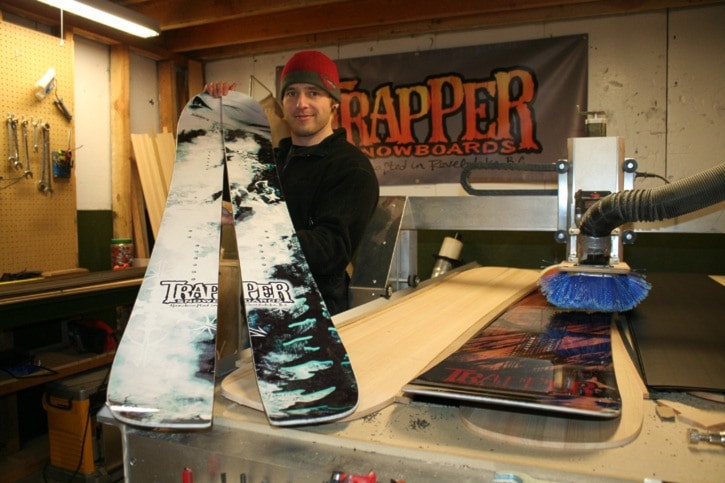Greg Fortier has assembled an impressive array of DIY machinery in Trapper Snowboards’ Big Eddy manufacturing operation. A computer-controlled cutting machine stamps out the shapes of the board and routs them to desired thicknesses. In the pressing room, he’s welded together a custom-designed snowboard press, which I’m not allowed to photograph due to some new, proprietary innovations on the device. There’s a custom fibreglass station, and lots of other heavy machinery he’s installed along with his business partner Tyler Riddell, (who was running errands on both my visits there).
Why does a guy from Alberta with a formal biology education and lots of hands-on technical know-how give up well-paying employment at CP Rail to start doing what everyone says can’t be done: running a small snowboard manufacturing operation?
“It’s not about money, it’s about lifestyle,” Fortier tells me. “I’m all in. I quit my job.”
So how is Trapper Snowboards going to pull it off? He brings out a custom-milled, locally-sourced Douglas Fir core and compares it side-by-side to one available off-the-shelf. Better wood, he explains. There’s no knots or imperfections in the milled-in-Revelstoke wood, and they work closely with their custom supplier to keep it that way. The tight grains are all vertically oriented. The other mass manufactured core reminds me of mid-grade plywood.
Fortier says the wood in the cores is often a function of where boards are manufactured, and has opted for local Douglas Fir. He says their longer pressing process gives more desirable form and lasting stiffness to the board. The fir decks are slightly heavier than traditional cores, but it’s only marginal, he says.
The other keys to success are keeping it local and authentic.
They delivered their first boards to local customers after starting up in 2011, and generated significant buzz at their booth at the Revelstoke Farm & Craft Market this summer. Fortier says many customer were interested in buying locally. Not necessarily local snowboards, just Revelstoke products. In fact, they originally planned to build out of a garage, but had to expand to meet demand.
Authentic riding in the Revelstoke context means the backcountry. While other snowboard companies’ riders must be part mountain legend, jib park progressionistas, fashion templates, media personalities and ski resort bar stars, Trapper has opted for a veteran team that focuses on backcountry riding. Scott Newsome, Al Clark and Joey Vosburgh make up their current roster. All are established riders with backcountry credentials.
Trapper currently has three main board designs. The Trout Trap is directional powder board. The Ursa Major is a directional freeride board and the Howler is an all-mountain powder twin. The boards are $650 each, $800 for the splitboard setup. Their signature shape is blunted tips and tails that come to a small, stylized point. The rocker and cambers vary between the boards; but they are all primarily designed for backcountry riding, generally meaning wider shapes with early rises to keep the boards atop of the deep snow.
All their boards are available as splitboards, and they are licensed by binding manufacturer Voile to incorporate their system into the board. Fortier says the splitboards are a significant slice of their manufacturing at this point.
They’ve also enlisted regional artists to complete their graphics. Their current designs are by Genevieve Sauviat (Nelson, B.C.), Hayley Stewart (Golden, B.C.), Rob Jobe (Salmon Arm, B.C.) and Cam Morris (Golden, B.C.).
Fortier says their stripped-down marketing plan also allows them to compete against mass manufacturers. They started word-of-mouth and plan mostly direct sales from their website at www.trappersnowboards.com. They’ll be partnering with key retailers, but want to keep the focus on authenticity and the backcountry experience.
Although snowboarding culture is diverse, a main thrust has always been targeting the key teenage demographic by selling the lifestyle – selling a star system. Teenagers from Quebec, Ontario and the eastern seaboard dream of running away to Whistler, shredding all day and rubbing shoulders with famous pros at night.
Whether it’s skis or snowboards, Revelstoke has kept its focus on the riding, and Trapper hopes to capitalize on that. You can’t shut down the bar every night if you’ve got a full day of skinning in front of you.
The popularity of splitboarding and sled-accessed backcountry riding has put the focus back on the mountains, especially here. “Snowboarding’s come full circle,” Fortier says. Trapper Snowboards hopes to ride that new focus into a sustainable business.
